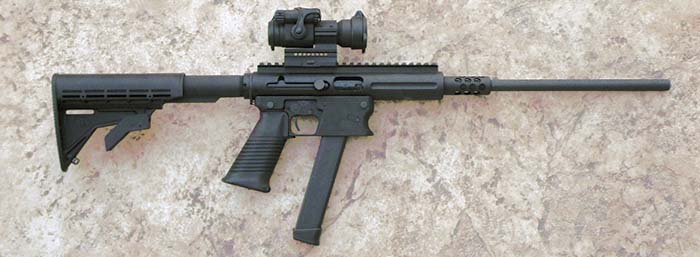By David Lake
Since the advent of repeating arms and cased ammunition, the goal and purpose of small arms manufacturers has been to improve and even specialize those weapons. Shoulder fired arms have to be divided into specific categories, ranging in size and power from the highly compact PDW, up to the robust anti-materiel rifle. In between these extremes you’ll find submachine guns, carbines, assault rifles, light machine guns, heavy machine guns, shotguns, launchers, and sniper rifles. Each represents a unique field of study, development, and application. Military and law enforcement will have access to, and a purpose for, all of the above weapon types. The civilian consumer will generally have less choice; whether collector, competitor, hobbyist, or hunter. The vast majority of guns lining the retail shelves today can be described with only two letters: AR. The overwhelming array of variants and versions of the AR-15 dominate our current gun market. The simple fact is that the AR-15 is so versatile it can be adapted to fill almost any role. As the gun-buying public supports the industry focused on the AR-15, we continue to see growing specialization and development for that platform. It would seem that the development and marketing of other weapon types is given less attention by most manufacturers of arms. It would seem that a well-developed carbine dedicated to firing a pistol cartridge does not command as much attention in the retail market.
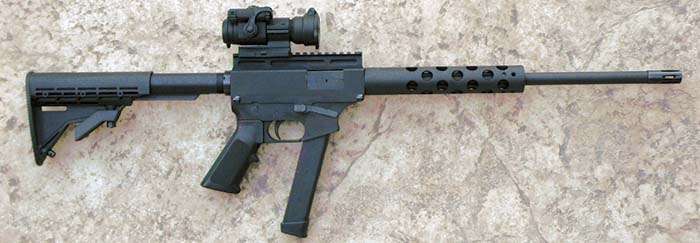
We should discuss the small arms arsenal of the two world wars. In World War One, scattered among the Mausers and Springfields and Carcanos, and Enfields and Hotchkiss and Maxims and Vickers of the day, there were the M15 Villar-Perosa, and the MP18 Bergmann. They were short, light (by comparison to the infantry rifles of the day) and fired pistol cartridges at the rate of a machine gun from very high-capacity magazines. In World War II we still see the presence of high-powered infantry rifles; but now, well developed on all fronts is the submachine gun. It is important to grasp this point that based on the lessons of World War One; every country that would be involved in the Second World War would develop and field a pistol caliber shoulder fired small arm. Government and military bodies had learned that battle engagements were typically happening at close to intermediate ranges. The infantry rifle’s size and power and potential to hit the horizon were proven unnecessary in most situations. The battlefield would eventually adopt a lighter, smaller rifle that could sustain automatic fire and hold 30 to 40 rounds and hit a man-sized target up to 150 yards away. To properly illustrate the proliferation of the pistol caliber carbine, here’s the short list of sub-guns from WWII: Thompson, M3 Grease Gun, Reising, Beretta 1918, Moschetto 38, Sten, Sterling, Lanchester, Owen, PPD-34, PPD-38, PPD-40, PPS-42, PPS-43, PPSH-41, UD-M42, LAD, Nambu type 100, Suomi, MAS 38, Ribeyrolle, Danuvia, Orita, Bechowiec, Blyskawica, Volks MP3008, MP28, MP34, Erma MP35, MP35 Bergmann, MP38, MP40, and MP41 etc., just to get the list started. Consider that 24 years prior to the start of WWII, only 2 submachine guns saw their start in World War 1. We need not argue in support of the efficacy and practicality of the SMG. History speaks well to that effect, by the marked proliferation of this class of weapon. The world’s militaries would eventually adopt the “assault rifle,” which fired a high velocity low impulse cartridge, featured large magazine capacities, and automatic fire capabilities; but only after the submachine gun had proven its worth. The assault rifle was only a logical next step for the SMG; it had greater effective range. The German MP43(44) and STG 44 assault rifles were the immediate descendants of the submachine gun. Today’s military and law enforcement have kept the submachine gun in service; mostly among SWAT and Special Forces units. The most notable and successful examples would be the ubiquitous Heckler & Koch MP5 from Germany and the infamous Uzi, from Israel. Most people would be hard-pressed to name any others. But can the average “Joe” get his hands on an SMG? The high price and legal restrictions on a transferrable submachine gun pushes many consumers out of that market. The closest many will get to owning one will come in the form of a semiautomatic pistol caliber carbine; referred to herein as a “PCC.”

Many major arms maker have offered a PCC at one time or another. Ruger and Marlin both made excellent PCCs in years past. Beretta, Calico, Kel-Tec, and Hi-Point offer their own unique PCCs – all incorporating very advanced design and materials. The Auto-Ordnance Thompson, Kriss Vector, FN PS90, and the HK 94 (and clones) represent true submachine guns that have been recreated in non-NFA configurations for the civilian market. Do-it-yourselfers have fostered a huge market for rebuilding old war surplus guns from parts kits. Salvaged Sten, Sterling, and Suomi semiautomatics have become quite common. There exists a family of devices that can be affixed to an existing handgun to render it a carbine; suggesting improved accuracy and handling characteristics that exceed the basic pistol. These are available from companies like FAB Defense, Command Arms Accessories, Hera Arms, MechTech and SIG Sauer. All but the MechTech employ the pistol’s existing short barrel, and require an NFA tax stamp for legal use. And the inherent accuracy, range, and effect of the pistol are not necessarily enhanced by simply adding a stock. Some firms that manufacture the AR-15 produce the AR rifle in pistol calibers. They either create a new receiver to accept the pistol magazine, or install a magazine adapter. The barrel, bolt, and some internal parts are also replaced in these converted rifles. But the platform is not purpose-built, and the resultant rifle maintains the size and weight of the basic AR-15. At times, this is desirable, as the manual of arms is the same no matter the AR-15’s chambering.
Then there is a small group of innovative companies that are making dedicated pistol caliber carbines that take a more practical approach to the PCC. They mimic the form or function of a familiar weapon platform as it’s quick to learn. They utilize commonly available parts and basic repairs are cheap and easy. Proprietary components are simple and robust – they’re durable and unlikely to fail. They might feature a quick caliber swap so the gun can adapted and upgraded easily, even without tools. They scale the weapon down for the pistol ammunition; so it can be made smaller and lighter. The result is a dedicated, purpose-built carbine. These companies have names like JRC, TNW, and Thureon Defense. The JRC is a slick little package; it’s approaching its 10th year of manufacture and has earned its accolades. But for this evaluation, we wanted something newer to the PCC market, so we procured some PCCs from two relative newcomers; Thureon Defense and TNW. We opted for the basic models from each company in 9mm luger.
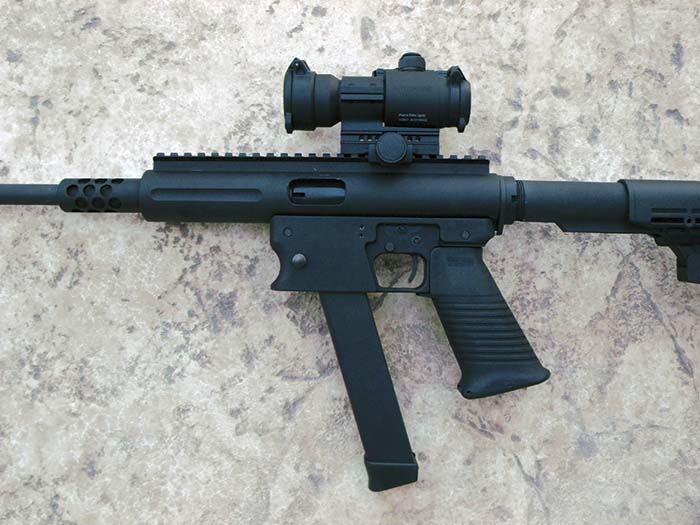
Thureon Defense GA Carbine
This PCC can be ordered in any of five calibers; 9mm, .40 S&W, .45 ACP, .357 SIG, and 10mm auto. The .357 and 10mm versions feature some unique internals to properly handle the increased pressure and velocities. This carbine can be ordered to work with any of five common magazine types; Glock, XD, M&P, SIG, or Uzi, and will soon be released to accept 1911 single stack magazines. Thureon’s PCC is not able to switch calibers or magazine well. What you get is what you get. This carbine can be ordered with a number of enhancements. These include a Picatinny-railed forend assembly, a slide-fire stock, and a selection of Magpul AR-15 furniture and components. The charging handle is on the left side of the receiver so it’s fast to operate with the shooter’s front hand and it ejects empties to the right. The gun is offered as a left-handed version with the charge handle and ejection switched accordingly. The Thureon borrows the fire control assembly from the AR-15, so it will accept any trigger upgrade meant for the AR-15. The stock trigger breaks at 5.5 pounds. The magazine release can be reached with the trigger finger. The lower receiver houses the fire control, magazine, feed ramp and ejector. The feed ramp and ejector are attached to the lower by screws and are easily replaced. The lower connects to the upper with two captive pins, not unlike the AR-15. The upper houses the barrel, bolt, forearm and an AR-15 buffer tube and stock. The forearm is not an AR part; it is unique to this gun as it acts as a jam nut against the receiver to lock the barrel in place. The barrel is threaded at the muzzle and comes equipped with a flash hider. A 16-inch barrel is standard and 19-inch is an option. A pistol and SBR version are available, both with 10.5-inch barrels. The GA can be stripped down to all its moving parts with only a pin punch for a tool. We must note that the Picatinny base atop the receiver is located one inch over the stock – one-half inch higher than we find it on the AR-15 and its derivatives. This is significant as most scopes mounts and sights are made to a specific proportion, which contributes to proper location of that sighting device while maintaining correct check weld. The extra height of the scope rail can cause some complication here.
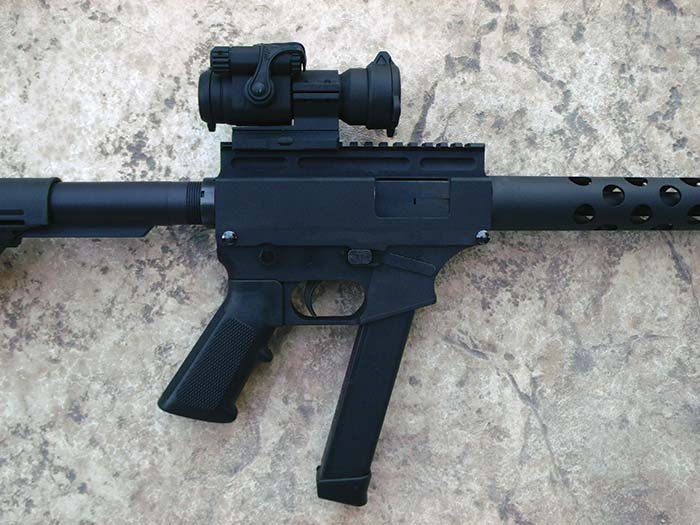
TNW Aero Survival Rifle (ASR)
The gun can be had in 9mm, .40 S&W, or .45 ACP. Conversion kits allow the gun to be swapped over in minutes, without tools. The TNW only accepts Glock magazines. The company has plans to release the ASR in .22 long rifle, .22 and .17 magnum, .357 SIG and 10mm auto. This PCC is offered in black, OD green, dark earth, pink camo and green camoflage anodized finishes. TNW does make a “bullet buttoned” model for states with restrictive “assault weapon” laws in place. It is also available as a pistol. The weapon is charged on the right side of the receiver, and ejection is user selectable to be toward the left or right. The quick-change barrel nut consists of a ventilated tube surrounding the first 3 inches of the barrel. Real estate on the receiver is cramped, or one could say that it “makes efficient use of space.” There is no forearm; the user’s front hand is meant to occupy a 4-inch section of receiver between the magazine and barrel nut. The TNW’s compact proportions remind one of the MP5K. If you’re wearing a glove, the trigger guard may be a tight squeeze. The factory trigger breaks at 4 and 1/4 pounds. The magazine release is located on the left side of the magazine well near the front of the receiver. We spent some time developing the muscle memory for the location of the magazine release; the button was often hard to find from a shooting position, but at the same time was easy to “bump” inadvertently with the wrist or palm. The receiver and full-length scope base are machined from a single block of aluminum. The Picatinny-style scope base is almost twice as long as that of the Thureon; this leaves more options and possibilities for optics selection. The TNW maintains the proper, standardized scope base height over the stock to ensure compatibility with common sights and optics. As standard equipment, this carbine includes a 4-inch Picatinny accessory rail that can be attached to the bottom front section of the receiver. This option costs extra on the Thureon. The internals are totally unique to the TNW. The fire control design looks to be derived from an FAL rifle. The upper and lower receivers are held together by two pins, similar to those of the AR-15, but on the TNW, the takedown pins are not held captive in the receiver. The ejector is held in with two roll pins, and is fast and easy to replace should the ejector ever break. The chamber is recessed into a deep pocket in the breech end of the barrel. This design creates a “feed chute” to guide the bullet toward the chamber. This is also a safety measure, to keep a ruptured case from blowing debris sideways from the ejection ports.
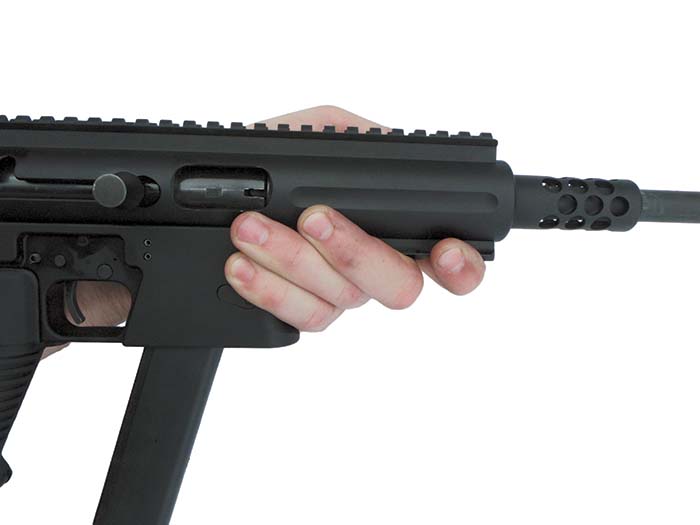
We headed to Pro Gun Club, just outside Las Vegas, to air these guns out. What we learned in our testing is that these two carbines are totally distinct from one-another. The Thureon GA carbine demonstrated tremendous accuracy; the best of it was a 2-inch group at 100 yards. There are full-sized high-power rifles on the market that can barely achieve this. The Thureon was as reliable as can be expected (with new, brass cased ammunition). We fired a total of 400 rounds through the GA carbine. 50 rounds of Wolf steel and 50 rounds of Blazer aluminum ammo both resulted in frustrating failures to eject and the occasional failure to fire. We experienced a 20% malfunction rate with this “bargain” ammunition. We tested the GA carbine with 300 rounds of brass-cased ammo, including hollow point, full metal jacket, frangible, commercial remanufactured and some hand loads. Bullet weights were 115, 124, 135, and 147 grains. Of this batch of ammo we only had two stoppages, which occurred with the commercial remanufactured ammo, and these came in the form of a “click” instead of a “bang.” This type of failure suggests a bad cartridge rather than a deficiency in the gun. At closer inspection of the remanufactured ammo, we found a few rounds that were not crimped at the case mouth which could prevent that cartridge from completely entering the chamber. The most satisfying thing about the Thureon was not that it produced excellent accuracy, but that the accuracy was extremely consistent for all bullet weights and types. The barrel is truly “match grade,” a term that is often misused today in order to sell a product. The accuracy of the TNW Aero Survival Rifle was not as impressive. At 100 yards the best we could print were 5 inch groups. Different bullet weights showed extreme point-of-impact shift (groups wandered several inches across the paper). So we could be realistic, and remind ourselves that it’s just a 9mm and 100 yards is asking a lot of it. If we look at it from another angle, a 3-inch 50 yard group is more than adequate. At ranges where a handgun would be appropriate, say, 5-20 yards, the TNW can easily make 1-inch groups. Most shooters cannot shoot that well with a 9mm handgun, so the TNW still greatly enhances the capability of the 9mm cartridge. The TNW did prove slightly better than the Thureon in terms of reliability. The Wolf and Blazer ammunition fed, fired and ejected as well as the brass-cased ammunition. That’s quite an achievement. The only repeated malfunction was a failure to eject with 147 grain subsonic ammo. This occurred 6 times out of 25 rounds of this ammunition type. Again, this was not indicative of a defect in the gun, only that this particular ammo was underpowered to cycle the weapon. The only real gripe we have for the TNW is that the barrel loosened a bit while firing. The barrel nut is engaged by a spring detent, which proved insufficient. The shifting point-of-impact and sporadic accuracy are likely due to the barrel nut loosening during operation.

We then took these guns away from the rifle range and put them on a CQB range where a gun’s personality really shows; employing these PCCs in some gun fighting scenarios involving hot reloads, left to right transitions, firing from different positions and barricades, rapid fire while moving, failure drills and double taps, up to 25 yards. The TNW was the clear winner here. The Thureon is longer, heavier, has more overall recoil and a pronounced muzzle rise. The compact nature of the TNW forces the shooter to really “saddle” the gun, and keep it all locked in tight. Its recoil impulse is very flat with almost no muzzle rise. All else being equal, this enhanced control is the result of the gun’s geometry. When we intentionally held the TNW “wrong” the muzzle flip became apparent. To prove this theory, we employed the same “locked in” hold on the Thureon, and were able to eliminate muzzle rise. We all know perfectly well that technique is everything; but the design of the TNW encourages a shooter to adopt a proper hold and stance – automatically and unconsciously – even if that shooter does not have or even understand shooting technique. Thus, the TNW proved to be more inherently “shootable.” Both guns proved excellent at the CQB role. At a full 25 yards, a rapid controlled pair of shots could be held within a 4 inch circle with the TNW. The Thureon’s muzzle flip would throw those same shots up to 8 inches apart. Still very good, and for all intents and purposes, both guns would serve well in this role. Compared to a 5.56mm rifle, a pistol carbine has very little muzzle blast. When working in and around barricades and obstacles, this is a valuable attribute of the PCC. The shooter’s senses are not overwhelmed by pressure, noise, dust, and blast; all common ailments of a high-powered rifle in a close-quarters environment.
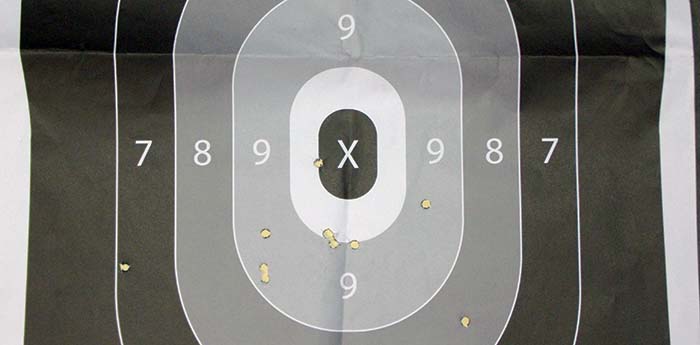
There are clear justifications to own a PCC. Some shooters can appreciate the soft recoil, or the total lack of muzzle blast. The ammunition can cost much less than 5.56mm NATO. Rules of a local or indoor shooting range may not allow rifle calibers. The PCC utilizes pistol magazines that a shooter may already own. The average shooter’s skill level may not be able to exploit the potential of a high-powered rifle. For the hunter, excess velocity can waste meat and damage a hide. A PCC can double or even triple the effective range of the handgun cartridge, making it a viable option for hunting small to medium game. For law enforcement, security, personal and home defense applications, a pistol cartridge has enough power to stop an assailant, without the danger of over-penetration of an intended target.
We cannot honestly say if one of these is better than the other. They each have their strengths and weaknesses. Any mechanical deficiencies are easy to overlook, as both of these guns are loads of fun to shoot and easy to operate and maintain. They are as effective and reliable as the ammunition used in them. The Thureon’s larger frame and familiar controls make its operation quick and instinctive. Its accuracy is beyond expectation. The TNW’s ergonomics make for more and faster hits on close targets. It is supremely suited for close quarters applications. We are pleased to see the AR-15 challenged for market share by weapons like these and the “dark horse” companies that make them. We hope to see TNW and Thureon continue to expand their product lines and gain prominence in the small arms market.
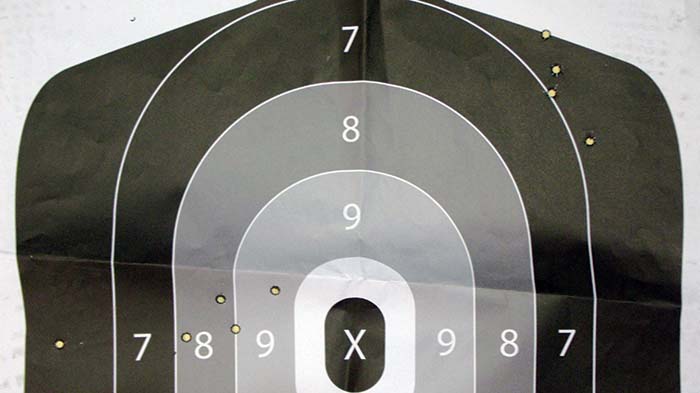
Thureon Defense
PO Box 173
New Holstein, WI, 53061
(920) 898-5859
www.thureondefense.com
info@thureondefense.com
TNW Firearms
(503) 429-5001
www.tnwfirearms.com
| This article first appeared in Small Arms Review V18N6 (December 2014) |



